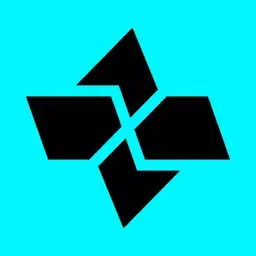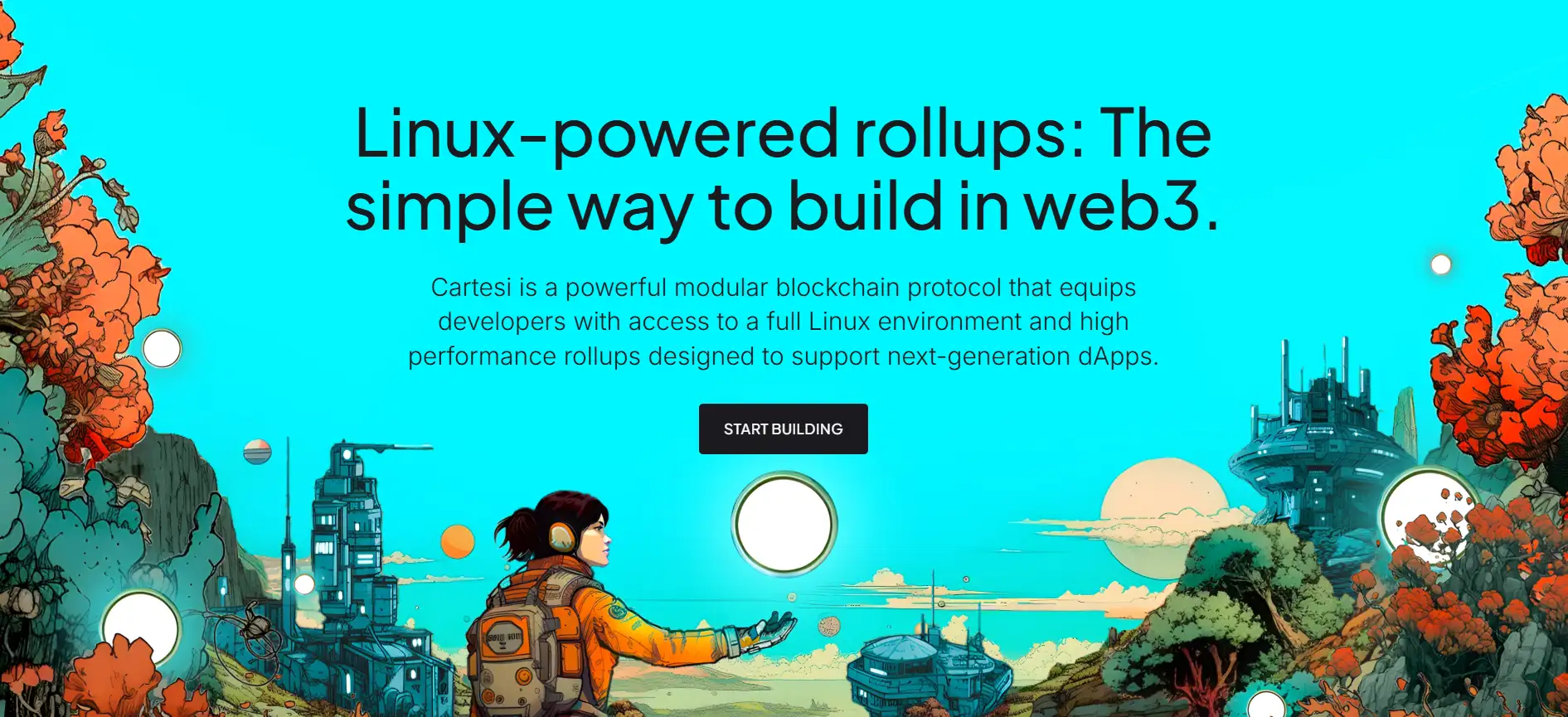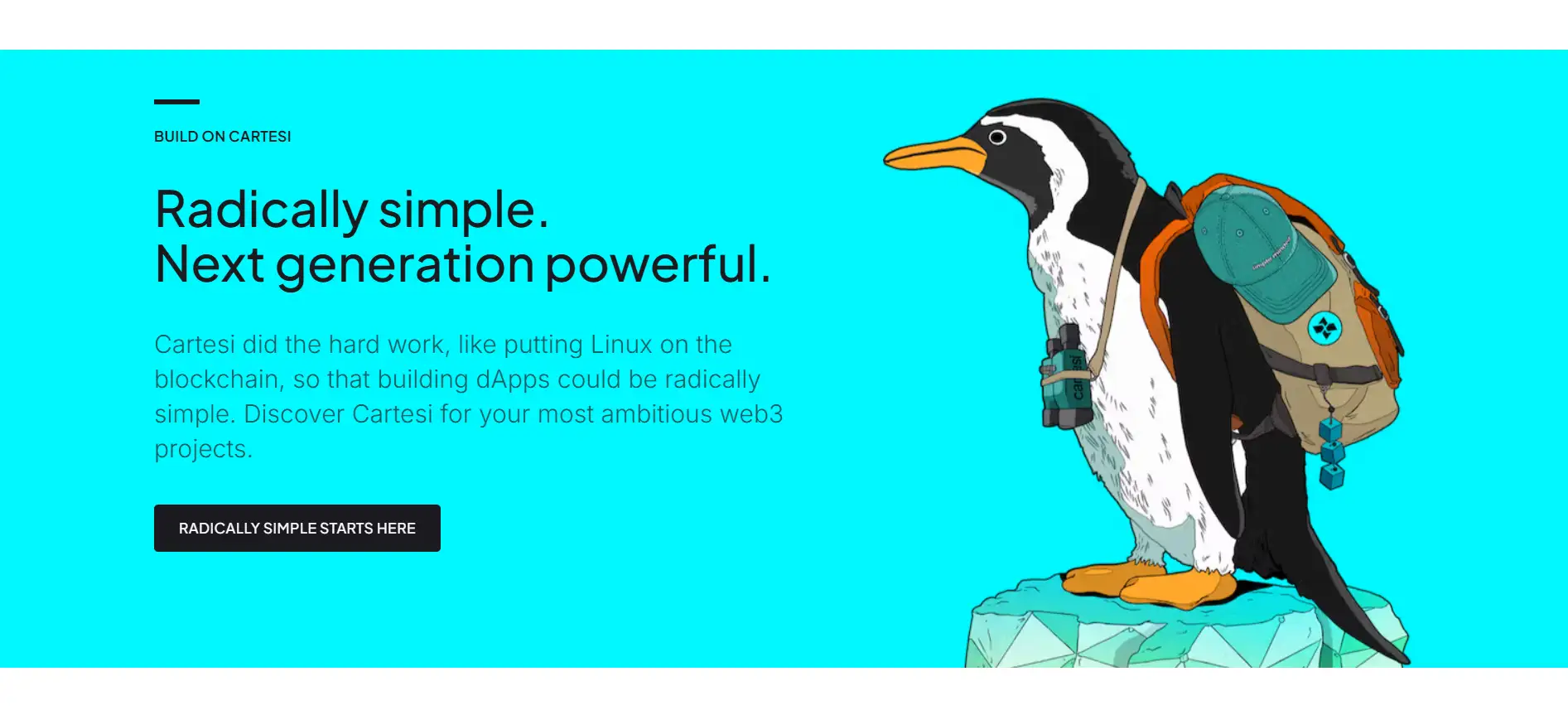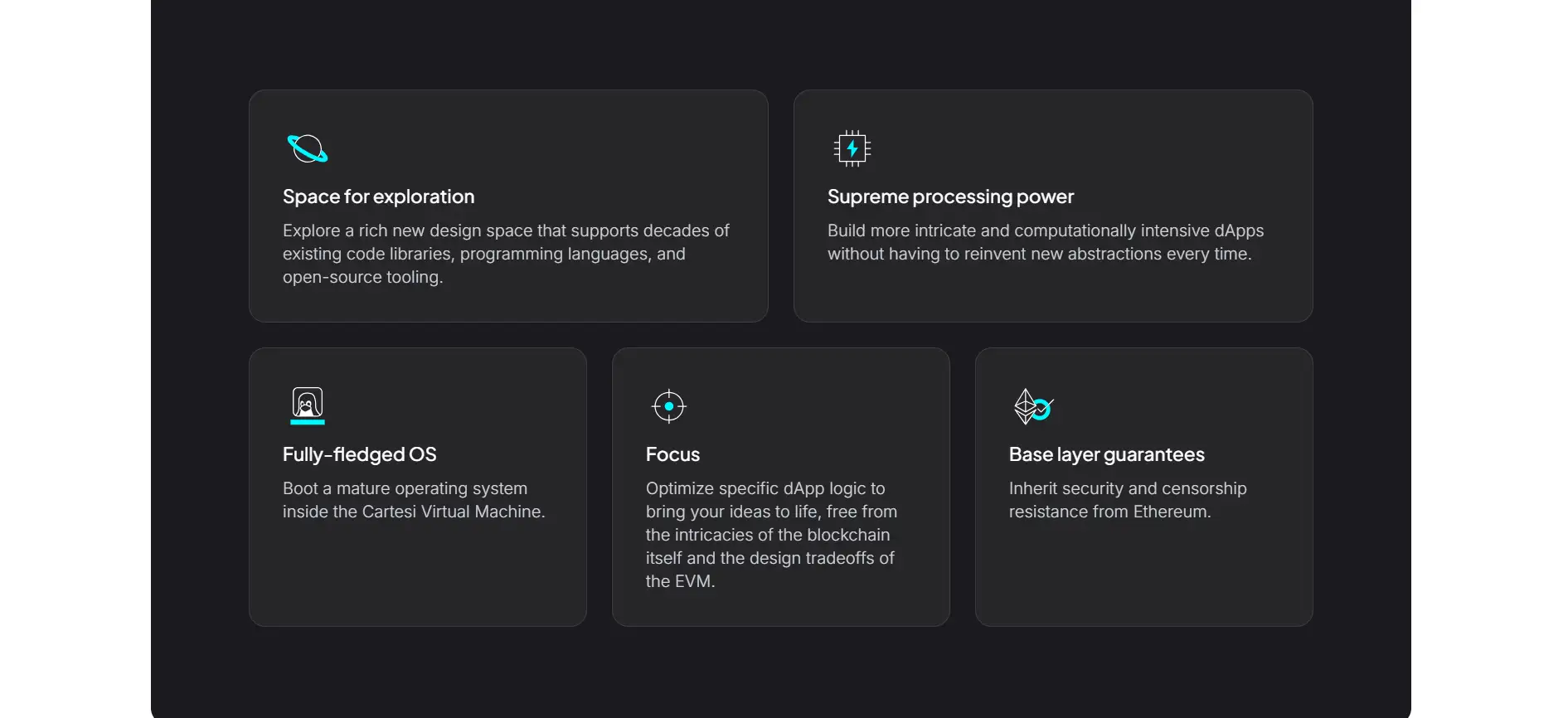About Cartesi
Cartesi is a next-generation modular blockchain protocol that brings the power of Linux to decentralized application development. Designed to overcome the limitations of the traditional Ethereum Virtual Machine (EVM), Cartesi empowers developers with a familiar, fully-fledged operating system and advanced rollup technology to build complex and scalable dApps.
By leveraging the Cartesi Virtual Machine and application-specific rollups, developers can build decentralized applications using mainstream programming languages, decades of mature libraries, and full-stack development tools. With its unique approach, Cartesi bridges the gap between traditional software engineering and blockchain innovation.
Cartesi is redefining the way dApps are built and scaled on blockchain networks. At its core, Cartesi introduces a powerful, modular framework that enables developers to build on-chain applications with access to a Linux environment, opening up compatibility with a vast universe of programming languages, toolchains, and legacy software systems. Its standout feature—the Cartesi Virtual Machine (CVM)—uses a RISC-V architecture to boot a full Linux OS, enabling the deployment of advanced logic that would be impractical or impossible with traditional smart contracts.
Through Cartesi Rollups, developers can launch app-specific optimistic rollups that scale computational resources vertically without sacrificing decentralization or security. These rollups are modular and customizable, allowing projects to tailor data availability, settlement layers, gas metering, and consensus configurations to suit their needs. Cartesi Rollups can function as Layer 2, Layer 3, or sovereign rollups, giving teams unprecedented flexibility over infrastructure design.
One of Cartesi’s major advantages lies in its scalability and performance. By offloading complex computations to its rollup layer while inheriting Ethereum’s base layer security, it allows dApps to achieve real-world throughput. Developers can implement sophisticated logic in familiar languages like C++, Python, or Rust—making it attractive for teams with traditional software backgrounds transitioning into Web3.
Cartesi’s approach supports cutting-edge applications across domains such as AI, DeFi, Gaming, and digital identity. Projects like ChainGPT, Bubblewars, RIVES, and DCA.Monstr demonstrate the diverse possibilities Cartesi unlocks. Compared to competitors like Arbitrum, Optimism, and zkSync, Cartesi offers deeper programmability and computational power via its Linux-based environment.
The open-source nature of Cartesi fosters transparency and innovation through a global community of developers, researchers, and contributors. Its governance model encourages collaborative evolution of the protocol, with a focus on research-driven upgrades and real-world applicability. This positions Cartesi not just as a layer for building, but a platform for experimentation and high-performance decentralized computing.
Cartesi provides a robust set of features and advantages designed to overcome the traditional constraints of blockchain development:
- Linux-Powered Development: Build dApps using a full Linux operating system, unlocking access to decades of mature libraries, frameworks, and programming languages.
- App-Specific Rollups: Gain access to dedicated computational resources through Cartesi’s rollups, enabling performance-intensive applications like AI and gaming.
- True Developer Flexibility: Write smart contract logic in any mainstream language such as C++, Rust, or Python using familiar development tools.
- Modular Architecture: Customize the stack—consensus, data availability, and gas metering—to meet the specific needs of your application.
- Enhanced Scalability: Offload heavy computations to Cartesi Rollups while retaining the security and decentralization of Ethereum.
- Decentralized and Verifiable AI: Integrate complex models and machine learning workflows in a decentralized, transparent, and auditable way.
- Low and Predictable Fees: Run cost-effective operations thanks to dedicated execution environments with predictable gas and performance metrics.
- Support for Next-Gen Use Cases: Cartesi unlocks innovation across AI, DeFi, Gaming, and Web3 tooling, going far beyond the limits of EVM-compatible chains.
Getting started with Cartesi is simple. Whether you’re building your first dApp or transitioning from traditional software development, Cartesi offers multiple paths to dive in:
- Visit the Developer Hub: Start your journey by exploring the Developer Hub for documentation, tutorials, and best practices.
- Use the Quickstart Guide: Access a step-by-step setup to build and launch a dApp using Cartesi Rollups. Visit the Quickstart Guide.
- Explore Example Projects: Check out real-world dApps built on Cartesi, including ChainGPT, RIVES, Bubblewars, and Memebet, to get inspired and learn from existing architectures.
- Connect with the Community: Join the conversation and get technical support through the Cartesi Discord and Twitter.
- Apply for a Grant: Submit your dApp proposal and receive funding via the Cartesi Grant Program. Applications are open via the Cartesi Grants Page.
- Watch and Learn: Follow along with video content, dev talks, and use case breakdowns on the Cartesi YouTube channel.
Cartesi FAQ
Cartesi introduces a novel blockchain operating environment by integrating a RISC-V virtual machine capable of booting a full Linux OS. This gives developers the ability to use Linux-native libraries, tools, and system calls in a decentralized environment. Developers can now deploy real software stacks on the blockchain using standard Linux tooling, unlocking a new era of full-featured dApp development. Learn more at cartesi.io.
Cartesi Rollups are application-specific, meaning each dApp runs on its own dedicated compute layer with customized logic, gas metering, and data availability. Unlike generic L2s, Cartesi Rollups allow you to choose your own execution paradigm while inheriting Ethereum’s base layer guarantees. This architecture provides the best of both worlds: custom performance without sacrificing decentralization and security. Explore more at cartesi.io.
Yes. With Cartesi Virtual Machine running Linux, you can develop decentralized applications using popular programming languages like Python, C++, Rust, and Go. This reduces onboarding time for Web2 developers and allows complex logic to be implemented using well-tested libraries. Cartesi’s environment removes the EVM's limitations, opening a broader spectrum of development possibilities. Visit the Developer Hub to start building.
Cartesi supports advanced AI and machine learning workflows by providing access to compute environments that can run pre-trained models, perform inferences, and operate complex logic off-EVM. Applications like ChainGPT and verifiable LLM inferences are already live on Cartesi. It’s the first blockchain OS that makes on-chain AI development practical, scalable, and verifiable.
Projects built on Cartesi span across AI (ChainGPT), Gaming (Bubblewars, RIVES), DeFi (DCA.Monstr), and even social identity and art (Peeps, Drawing Canvas). These applications leverage Cartesi’s computational power to offer features that are impossible with traditional smart contracts.
You Might Also Like












